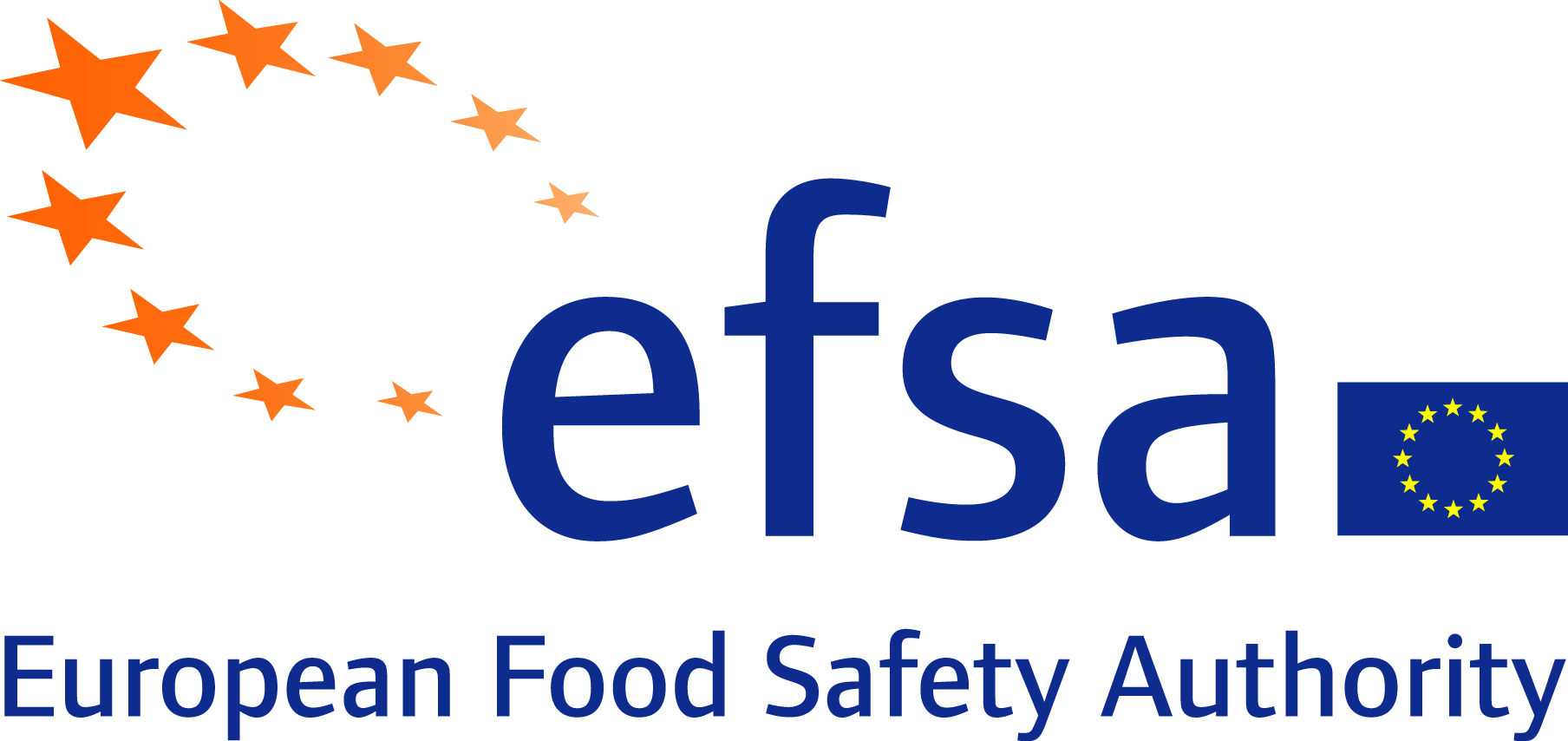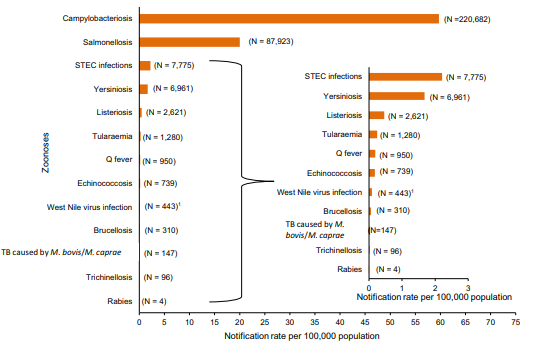A 2019 report on the European Union on foodborne outbreaks, illnesses, and death
 A recent report by the EFSA and the European Centre for Disease Prevention and Control, presented the results of zoonoses monitoring activities conducted in 2019 in 36 European countries (28 Member States (MS) and eight non-MS).
A recent report by the EFSA and the European Centre for Disease Prevention and Control, presented the results of zoonoses monitoring activities conducted in 2019 in 36 European countries (28 Member States (MS) and eight non-MS).
According to the report, the number of people getting sick and dying in foodborne outbreaks in Europe went slightly up in 2019. The most-reported zoonosis in humans was campylobacteriosis, representing 50% of the cases, followed by salmonellosis. The number of cases of these two diseases was stable during 20`5-2019. The third most reported zoonosis in humans was Shiga toxin-producing Escherichia coli (STEC), which increased from 2015 to 2019. Yersiniosis was the fourth most reported in 2019, with a stable trend in 2015–2019. Listeriosis cases followed and remained stable in 2015–2019 after a long period of increase. Unlike the US, Europe does not have zero tolerance for the presence of Listeria, and Listeria that seldom exceeded the EU food safety limit in ready-to-eat food. However, listeriosis was the most severe disease with the highest fatality and hospitalization.
 Reported outbreaks of human zoonoses in EU 2019
Reported outbreaks of human zoonoses in EU 2019
In total, 5,175 foodborne outbreaks were reported in the EU in 2019. They involved 49,463 illnesses, 3,859 hospitalizations, and 60 deaths. Salmonella remained the most detected agent. Norovirus in fish and its products was the agent/food pair causing the highest number of outbreaks.
In this blog we will not cover the updates related to bovine tuberculosis, Brucella, Trichinella, Echinococcus, Toxoplasma, rabies, West Nile virus, Coxiella burnetii (Q fever), and tularaemia that are covered in the EU report.
Campylobacter
Campylobacteriosis is the most frequently reported gastrointestinal infection in humans in the EU and has been so since 2005. Campylobacter was the third most frequently reported organism to cause foodborne outbreaks at the EU in 2019. There have been 220,682 Cases, with 254 cases of illness, 125 hospitalizations, and no deaths. As in earlier years, the most common sources for campylobacteriosis foodborne outbreaks were broiler meat and milk. In 2019, Campylobacter Salmonella and accounted for 71% of the confirmed foodborne illnesses in the US.

Salmonella
In the EU, Salmonellosis is the second most commonly reported gastrointestinal infection in humans, with 87,923 confirmed cases. After a long period of a declining trend, the salmonellosis case did not change significantly in the last five years. There have been 926 salmonellosis foodborne outbreaks in 2019, causing 9,169 illnesses, 1,915 hospitalizations (50.5% of all outbreak-related hospitalizations), and seven deaths. Salmonella caused 17.9% of all foodborne outbreaks during 2019.
S. Enteritidis caused most (72.4%) of the salmonellosis foodborne outbreaks. The most implicated foods were egg and egg products, bakery products, and hog products. Among 606 outbreaks where information on the Salmonella serovar was available, Enteritidis was top with 439 outbreaks, followed by Typhimurium with 85.
Listeria
In 2019 EU reported 2,621 confirmed invasive human cases of listeriosis with a notification rate of 0.46 cases per 100,000 populations, which was at the same level as in 2018. Listeria infections were most frequently reported in the age group over 64 years, particularly in the age group over 84.
The overall EU case fatality was high (17.6%) and it increased compared with 2018 and 2017 (13.6% and 15.6%, respectively). This makes listeriosis one of the most severe foodborne diseases under EU surveillance. The number of outbreaks caused by L. monocytogenes (21) was 50% higher compared with 2018 (14). The related illnesses increased from a total number of 748 cases reported at the EU level between 2010 and 2018 (83.4 annual cases on average) to 349 cases. The increase was primarily due to an outbreak in Spain, which reported three outbreaks, 225 cases, 131 hospitalizations, and three deaths, compared with zero reported in 2018.
Shiga toxin-producing Escherichia coli
In 2019, 7,775 confirmed Shiga toxin-producing E. coli (STEC) infections in humans were reported at the EU. The notification rate was 2.2 cases per 100,000 populations, which was similar in 2018. STEC was the third most frequent bacteria detected in foodborne outbreaks in the EU, with 42 outbreaks, 273 cases, 50 hospitalizations, and one death reported in 2019. The trend has been increasing from 2015 to 2019. The primary source of infection was bovine meat, milk, and vegetables.
STEC was the third most frequent bacteria detected in the EU, with 42 outbreaks, 273 cases, 50 hospitalizations, and one death. STEC O157 (9), O26 (7), and O145 (1) were most frequently found.

Foodborne outbreaks
During 2019, the 27 Member States reported 5,175 foodborne outbreaks involving 49,463 cases of illness, 3,859 hospitalizations, and 60 deaths. Also, 117 outbreaks, 3,760 cases of illness, and 158 hospitalizations were communicated by six non-member states.
Listeria monocytogenes had a significant role in foodborne outbreaks since it was responsible for 349 cases of illness and more than 50% of total outbreak-associated deaths (31 deaths; 10 deaths more than in 2018; 29 more than in 2017). L. monocytogenes infection in the EU has continuously increased over the last four years.
Salmonella was the agent most identified in foodborne outbreaks (926), accounting for 17.9% of the total outbreaks. Salmonella also caused the highest number of hospitalizations (49.6%). Noroviruses in fish and its products caused the highest number (145) of outbreaks, mainly driven by a rise in France.
Salmonella was to blame for the highest number of hospitalizations (1,915), and L. monocytogenes alone caused more than 50% of the fatal illnesses (31). The number of deaths due to L. monocytogenes doubled compared to 2018 (10 deaths more than in 2018; 47.6% increase).
Foods of animal origin were associated with most, 469 foodborne outbreaks and 5,709 illnesses. Food from animal origins was mainly implicated in incidents caused by Salmonella, norovirus, histamine, Clostridium perfringens, and Campylobacter. Eggs and egg products were implicated in 108 outbreaks, since there was one large outbreak with more than 100 patients.
